Inversion of Rice Biophysical Parameters Using Simulated Compact Polarimetric SAR C-Band Data
Abstract
:1. Introduction
2. Study Site, Data Source, and Ground Measurement Campaign
3. Methodology
3.1. CP SAR Data Simulation
3.2. Extraction of CP SAR Parameters and Data Preprocessing
3.3. The Inversion Model of Rice Parameters Building with CP SAR
3.3.1. The Inversion Model of Rice Parameters Using CP Backscatter and WCM
3.3.2. Construction of the MWCM
3.3.3. Coupling the CP Parameters from the m-χ and m-δ Decomposition with the MWCM.
3.3.4. Calculating the Model Parameters Based on the GA of Rice Characteristics
- (1)
- Initialization and Genetic Representation
- (2)
- Reproduction
- (3)
- Cross-over
- (4)
- Mutation
- (5)
- Termination Criteria
4. Results and Discussions
4.1. Inversion of Rice Biophysical Parameters Using CP Backscattering Coefficients
4.2. Inversion of Rice Biophysical Parameters Using Stokes Parameters
4.3. Inversion of Rice Biophysical Parameters Using m-χ and m-δ Decomposition Parameters
5. Conclusions
- (1)
- Using the four CP backscattering coefficients (RH/RV/RR/RL), the inversion results of h and mv_s were superior to those of LAI and De, with the R2 above 0.81 and the RMSE less than 10 cm and 0.39 kg/m3, respectively. RV had the best performance in the inversion of h and mv_s. For De, RH and RR performed better than RV and RL, giving an R2 above 0.85 and an RMSE of less than 0.18 kg/m2. Again, the inversion results for the LAI were the poorest, with RV and RL giving better results than RH and RR. For RL, the R2 was 0.73, and the RMSE was less than 0.55.
- (2)
- Using the Stokes parameters, the inversion results for the four rice biophysical parameters were good. For h, the R2 had a value of about 0.92, and the RMSE was less than 5.8 cm. For mv_s, the R2 was about 0.93, and the RMSE was less than 0.36 kg/m3. For De, the R2 was about 0.80, and the RMSE was less than 0.21 kg/m2. The inversion results for the LAI were the poorest, with an R2 of 0.75 and an RMSE of up to 0.45.
- (3)
- Using the m-χ and m-δ decomposition parameters, the inversion accuracy for h and De was higher than for mv_s and the LAI. For h, the coefficient of determination, R2, was about 0.88, and the RMSE was less than 8.2 cm. For De, the R2 was 0.89, and the RMSE was less than 0.17 kg/m2. For mv_s, the coefficient of determination was 0.83, and the RMSE was less than 0.6 kg/m3. As before, the inversion results for the LAI had the lowest accuracy, with an R2 of 0.73 and an RMSE up to 0.55. Overall, the h and De inversion results obtained using the m-χ decomposition parameters were better than those obtained using the m-δ decomposition. For LAI and mv_s, the accuracy obtained using the m-δ decomposition was slightly higher than that found using the m-χ decomposition. In the early stages of rice growth, mv_s was slightly overestimated; in the case of the m-χ decomposition parameters, this overestimation was even greater.
- (4)
- In general, S1, RV, RL, and the m-χ decomposition parameters proved to be more suitable for the inversion of h, and high inversion accuracy was obtained. S1, RH, RV, RR, and RL are more suitable for inverting mv. RH, RR, and the decomposition parameters are more suitable for inverting De.
Author Contributions
Acknowledgments
Conflicts of Interest
References
- Maclean, J.L.; Dawe, D.C.; Hardy, B.; Patel, G.P. Rice Almanac: Source Book for the Most Important Economic Activity on Earth; International Rice Research Institute: Los Banos, Philippines, 2002; p. 253. ISBN 971-22-0172-4. [Google Scholar]
- Toan, T.L.; Ribbes, F.; Wang, L.F.; Floury, N.; Ding, K.H.; Kong, J.A.; Fujita, M.; Kurosu, T. Rice crop mapping and monitoring using ERS-1 data based on experiment and modeling results. IEEE Trans. Geosci. Remote Sens. 1997, 35, 41–56. [Google Scholar] [CrossRef]
- Bouvet, A.; Toan, T.L.; Lam-Dao, N. Monitoring of the Rice Cropping System in the Mekong Delta Using ENVISAT/ASAR Dual Polarization Data. IEEE Trans. Geosci. Remote Sens. 2009, 47, 517–526. [Google Scholar] [CrossRef] [Green Version]
- Shao, Y.; Fan, X.; Liu, H.; Xiao, J.; Ross, S.; Brisco, B.; Brown, R.; Staples, G. Rice monitoring and production estimation using multitemporal RADARSAT. Remote Sens. Environ. 2001, 76, 310–325. [Google Scholar] [CrossRef]
- Erten, E.; Lopez-Sanchez, J.M.; Yuzugullu, O.; Hajnsek, I. Retrieval of agricultural crop height from space: A comparison of SARtechniques. Remote Sens. Environ. 2016, 187, 130–144. [Google Scholar] [CrossRef]
- Tan, L.; Chen, Y.; Jia, M.; Tong, L.; Li, X.; He, L. Rice biomass retrieval from advanced synthetic aperture radar image based on radar backscattering measurement. J. Appl. Remote Sens. 2015, 9, 097091. [Google Scholar] [CrossRef] [Green Version]
- Raney, R.K.; Spudis, P.D.; Bussey, B.; Crusan, J.; Jensen, J.R.; Marinelli, W.; Mckerracher, P.; Neish, C.; Palsetia, M.; Schulze, R. The Lunar Mini-RF Radars: Hybrid Polarimetric Architecture and Initial Results. Proc. IEEE 2011, 99, 808–823. [Google Scholar] [CrossRef]
- Kunhikrishnan, P.; Sowmianarayanan, L.; Nampoothiri, M.V. PSLV-C19/RISAT-1 mission: The launcher aspects. Curr. Sci. 2013, 104, 472–476. [Google Scholar]
- Arikawa, Y.; Suzuki, S. ALOS-2 launch and initial checkout result. In Proceedings of the Sensors, Systems, and Next-Generation Satellites XVIII, Amsterdam, The Netherlands, 11 November 2014. [Google Scholar]
- Sanden, J.J.V.D.; Geldsetzer, T. Compact Polarimetry in Support of Lake Ice Breakup Monitoring: Anticipating the RADARSAT Constellation Mission. Can. J. Remote Sens. 2015, 41, 440–457. [Google Scholar] [CrossRef]
- Brisco, B.; Li, K.; Tedford, B.; Charbonneau, F.; Yun, S.; Murnaghan, K. Compact polarimetry assessment for rice and wetland mapping. Int. J. Remote Sens. 2013, 34, 1949–1964. [Google Scholar] [CrossRef]
- Uppala, D.; Kothapalli, R.V.; Poloju, S.; Mullapudi, S.S.V.R.; Dadhwal, V.K. Rice Crop Discrimination Using Single Date RISAT1 Hybrid (RH, RV) Polarimetric Data. Photogramm. Eng. Remote Sens. 2015, 81, 557–563. [Google Scholar] [CrossRef]
- Li, K.; Brisco, B.; Shao, Y.; Touzi, R. Polarimetric decomposition with RADARSAT-2 for rice mapping and monitoring. Can. J. Remote Sens. 2012, 38, 169–179. [Google Scholar] [CrossRef]
- Watanabe, T.; Izumi, Y.; Tetuko, J.; Sumantyo, S. Comparison of three compact-SAR mode through rice phenology monitoring. In Proceedings of the International Symposium on Antennas and Propagation (ISAP), Phuket, Thailand, 30 October–2 November 2017. [Google Scholar]
- Yang, Z.; Li, K.; Liu, L.; Shao, Y.; Brisco, B.; Li, W. Rice growth monitoring using simulated compact polarimetric C band SAR. Radio Sci. 2014, 49, 1300–1315. [Google Scholar] [CrossRef] [Green Version]
- Lopez-Sanchez, J.M.; Vicente-Guijalba, F.; Ballester-Berman, J.D.; Cloude, S.R. Polarimetric Response of Rice Fields at C-Band: Analysis and Phenology Retrieval. IEEE Trans. Geosci. Remote Sens. 2014, 52, 2977–2993. [Google Scholar] [CrossRef] [Green Version]
- Kumar, V.; Mcnairn, H.; Bhattacharya, A.; Rao, Y.S. Temporal Response of Scattering From Crops for Transmitted Ellipticity Variation in Simulated Compact-Pol SAR Data. IEEE. Sel. Top. Appl. Earth Obs. Remote Sens. 2017, 10, 5163–5174. [Google Scholar] [CrossRef]
- Zhang, W.; Li, Z.; Chen, E.; Zhang, Y.; Yang, H.; Zhao, L.; Ji, Y. Compact Polarimetric Response of Rape (Brassica napus L.) at C-Band: Analysis and Growth Parameters Inversion. Remote Sens. 2017, 9, 591. [Google Scholar]
- Yang, H.; Xie, L.; Chen, E.X.; Zhang, H.; Yang, G.J.; Li, Z.H.; Gu, X.H. Biomass estimation of oilseed rape using simulated compact polarimtric SAR imagery. In Proceedings of the 2016 IEEE International Geoscience and Remote Sensing Symposium (IGARSS), Beijing, China, 10–15 July 2016. [Google Scholar]
- Ulaby, F.; Allen, C.; Eger, G.; Kanemasu, E. Relating the microwave backscattering coefficient to leaf area index. Remote Sens. Environ. 1984, 14, 113–133. [Google Scholar] [CrossRef]
- Thompson, A.A.; Mcleod, I.H. The RADARSAT-2 SAR processor. Can. J. Remote Sens. 2004, 30, 336–344. [Google Scholar] [CrossRef]
- Shi, Z.Y.; Gao, X.F.; Xie, Y. The application of SUNSCAN canopy analysis system in the measurement of field ecosystem. Agric. Res. Arid Areas 2005, 23, 78–82. [Google Scholar]
- Attema, E.; Ulaby, F.T. Vegetation modeled as a water cloud. Radio Sci. 1978, 13, 357–364. [Google Scholar] [CrossRef]
- Raney, R.K. Hybrid-Polarity SAR Architecture. IEEE Trans. Geosci. Remote Sens. 2007, 45, 3397–3404. [Google Scholar] [CrossRef]
- Yin, J.; Yang, J. Ship detection by using the M-Chi and M-Delta decompositions. In Proceedings of the 2016 IEEE International Geoscience and Remote Sensing Symposium (IGARSS), Quebec, QC, Canada, 13–18 July 2014. [Google Scholar]
- Raney, R.K.; Cahill, J.S.T.S.; Patterson, G.W.; Bussey, D.B.J. The m-chi decomposition of hybrid dual-polarimetric radar data. In Proceedings of the 2012 IEEE International Geoscience and Remote Sensing Symposium, Munich, Germany, 22–27 July 2012. [Google Scholar]
- Yang, Z.; Li, K.; Shao, Y.; Brisco, B.; Liu, L. Estimation of Paddy Rice Variables with a Modified Water Cloud Model and Improved Polarimetric Decomposition Using Multi-Temporal RADARSAT-2 Images. Remote Sens. 2016, 8, 878. [Google Scholar] [CrossRef]
- Beriaux, E.; Lucau-Danila, C.; Auquiere, E.; Defourny, P. Multiyear independent validation of the water cloud model for retrieving maize leaf area index from SAR time series. Int. J. Remote Sens. 2013, 34, 4156–4181. [Google Scholar] [CrossRef]
- Lievens, H.; Verhoest, N.E.C. On the Retrieval of Soil Moisture in Wheat Fields from L-Band SAR Based on Water Cloud Modeling, the IEM, and Effective Roughness Parameters. IEEE Geosci. Remote Sens. Lett. 2011, 8, 740–744. [Google Scholar] [CrossRef]
- Bériaux, E.; Waldner, F.; Collienne, F.; Bogaert, P.; Defourny, P. Maize Leaf Area Index Retrieval from Synthetic Quad Pol SAR Time Series Using the Water Cloud Model. Remote Sens. 2015, 7, 16204–16225. [Google Scholar] [CrossRef] [Green Version]
- Golberg, D.E. Genetic Algorithms in Search, Optimization, and Machine Learning; Addison Wesley: Boston, MA, USA, 1989. [Google Scholar]
- Kumar, K.; Hari Prasad, K.S.; Arora, M.K. Estimation of water cloud model vegetation parameters using a genetic algorithm. Hydrol. Sci. J. 2012, 57, 776–789. [Google Scholar] [CrossRef] [Green Version]
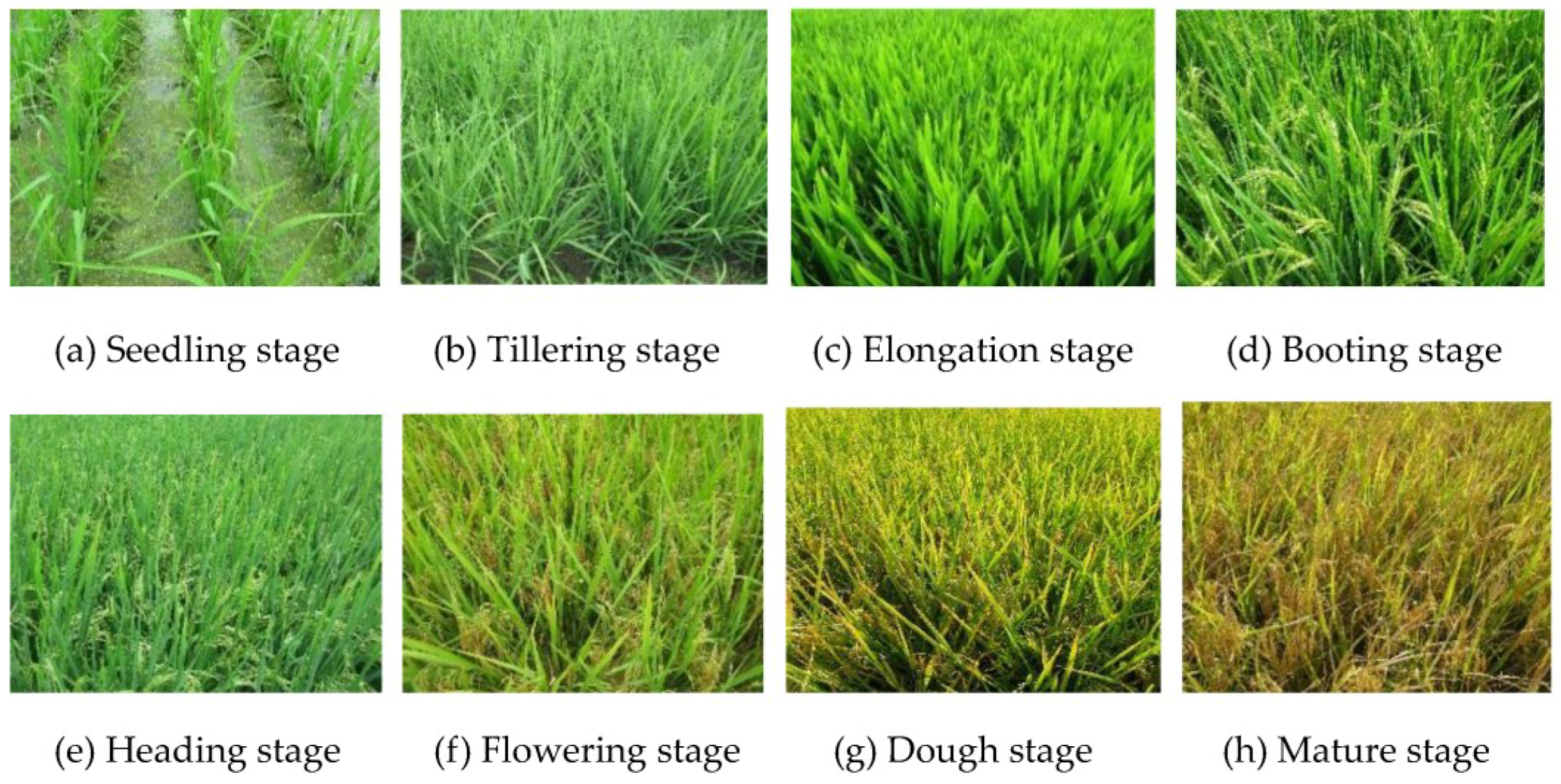
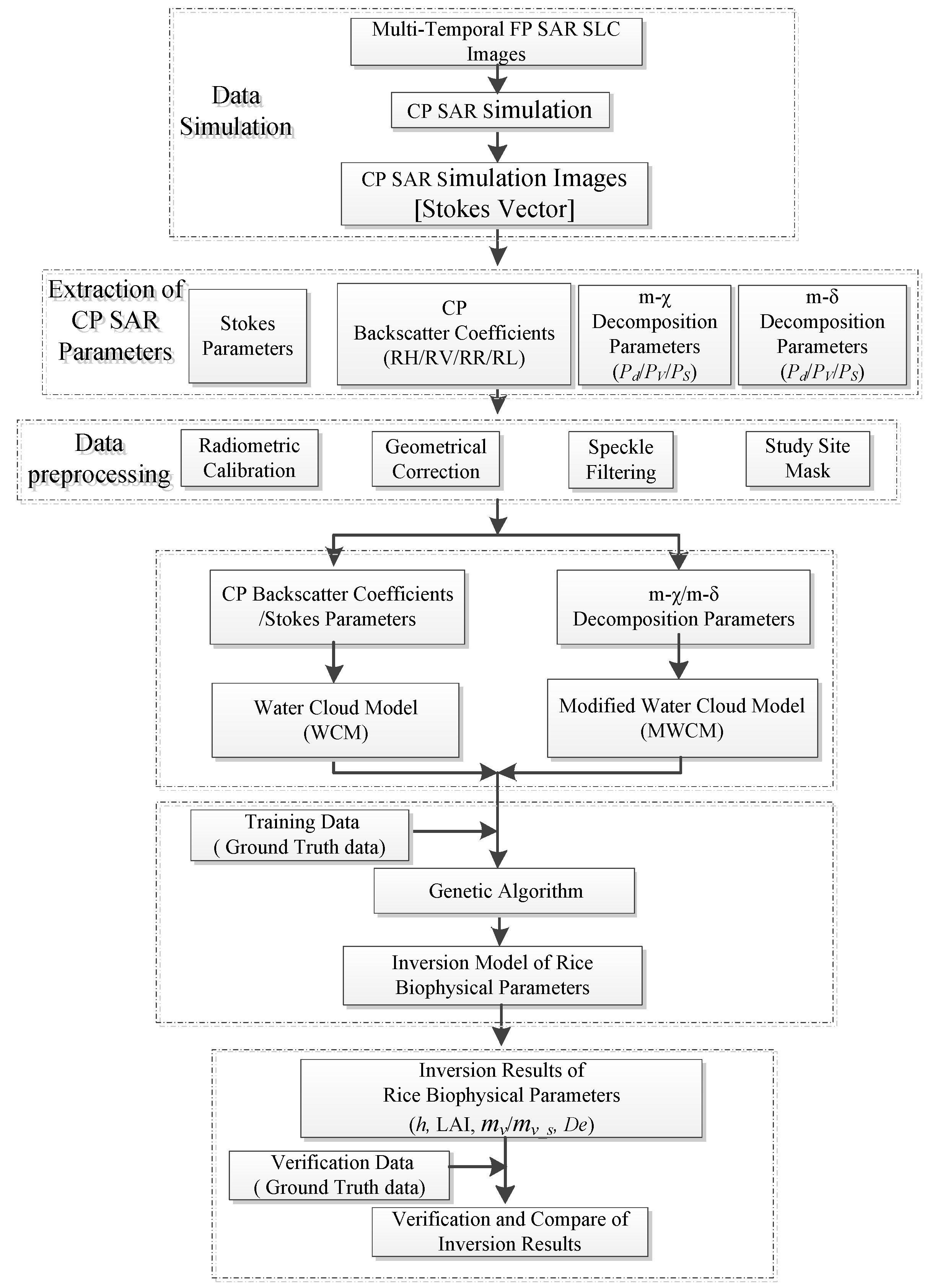

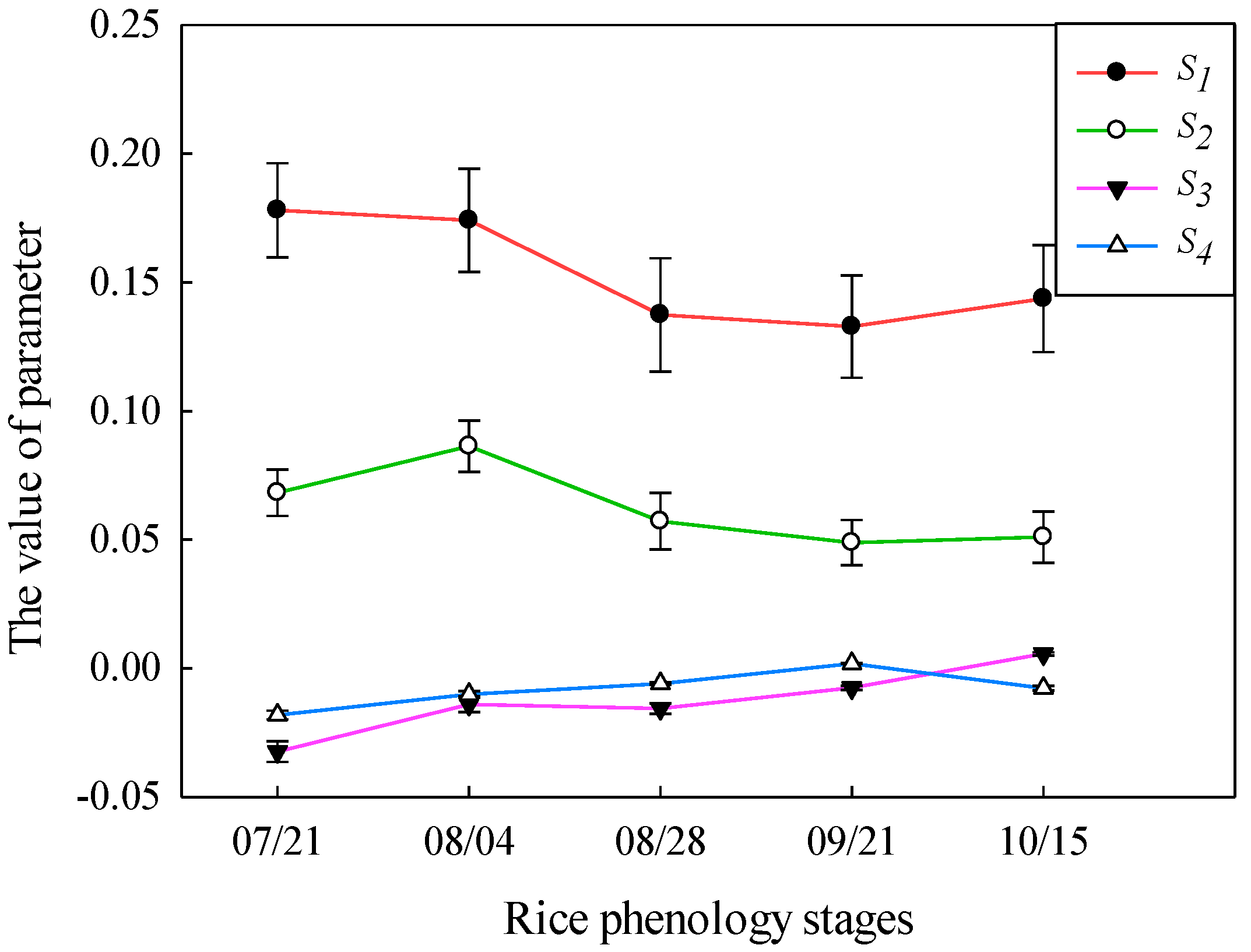

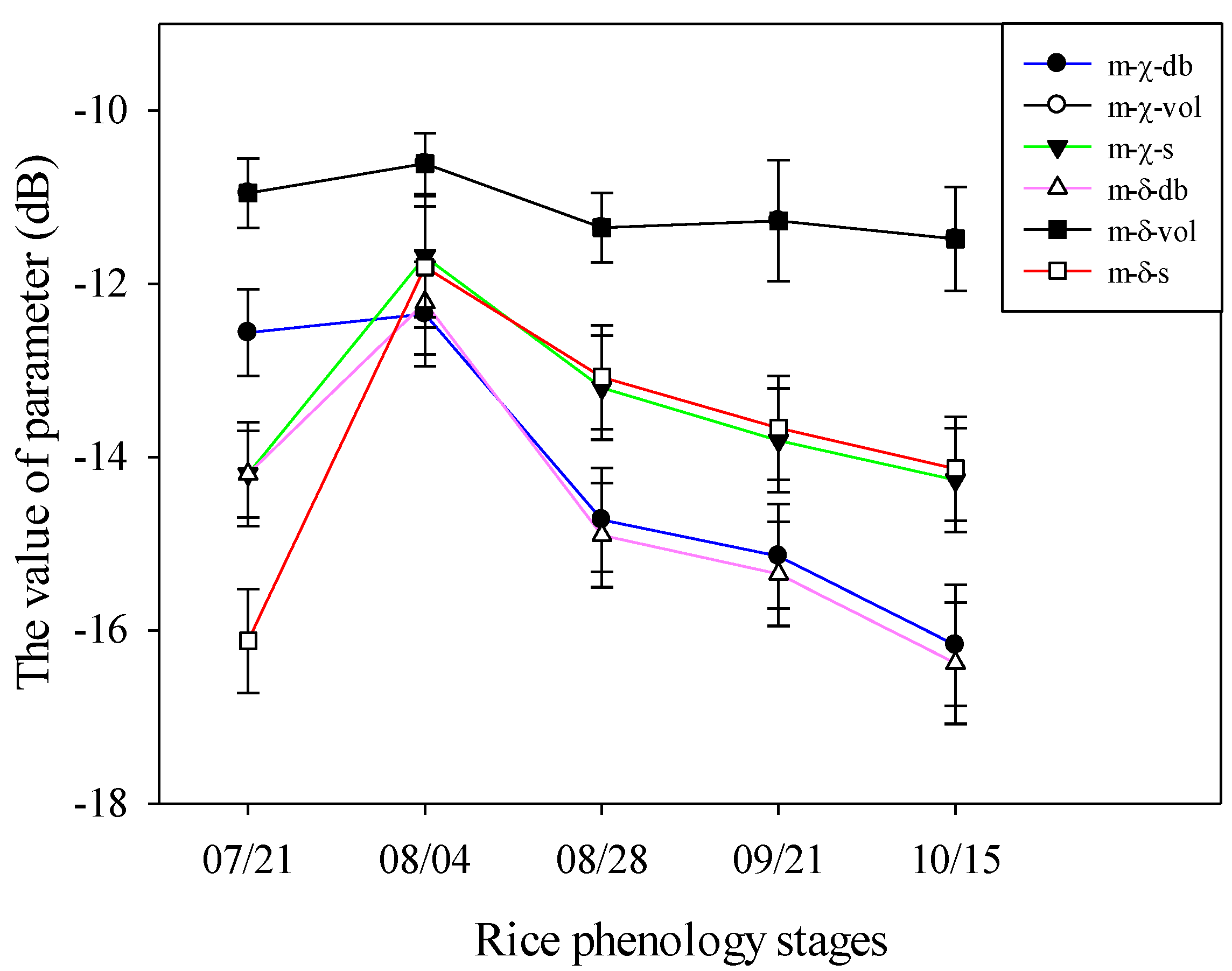



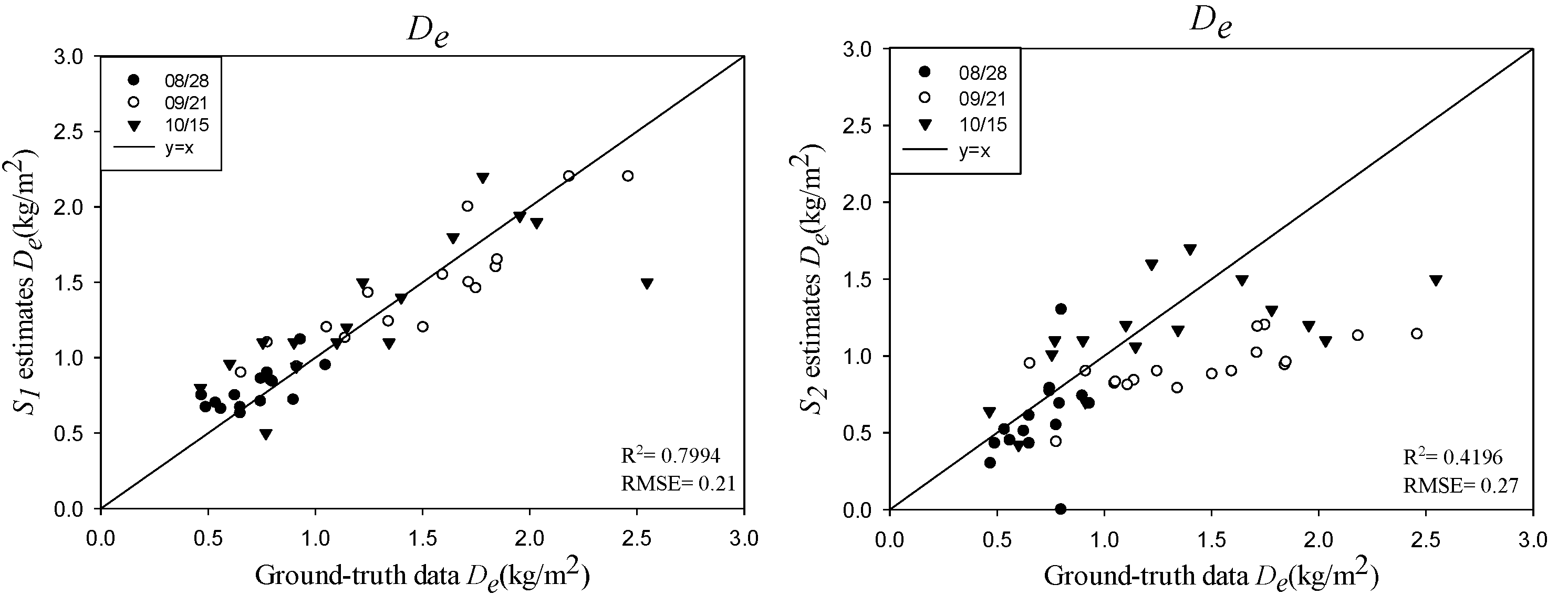
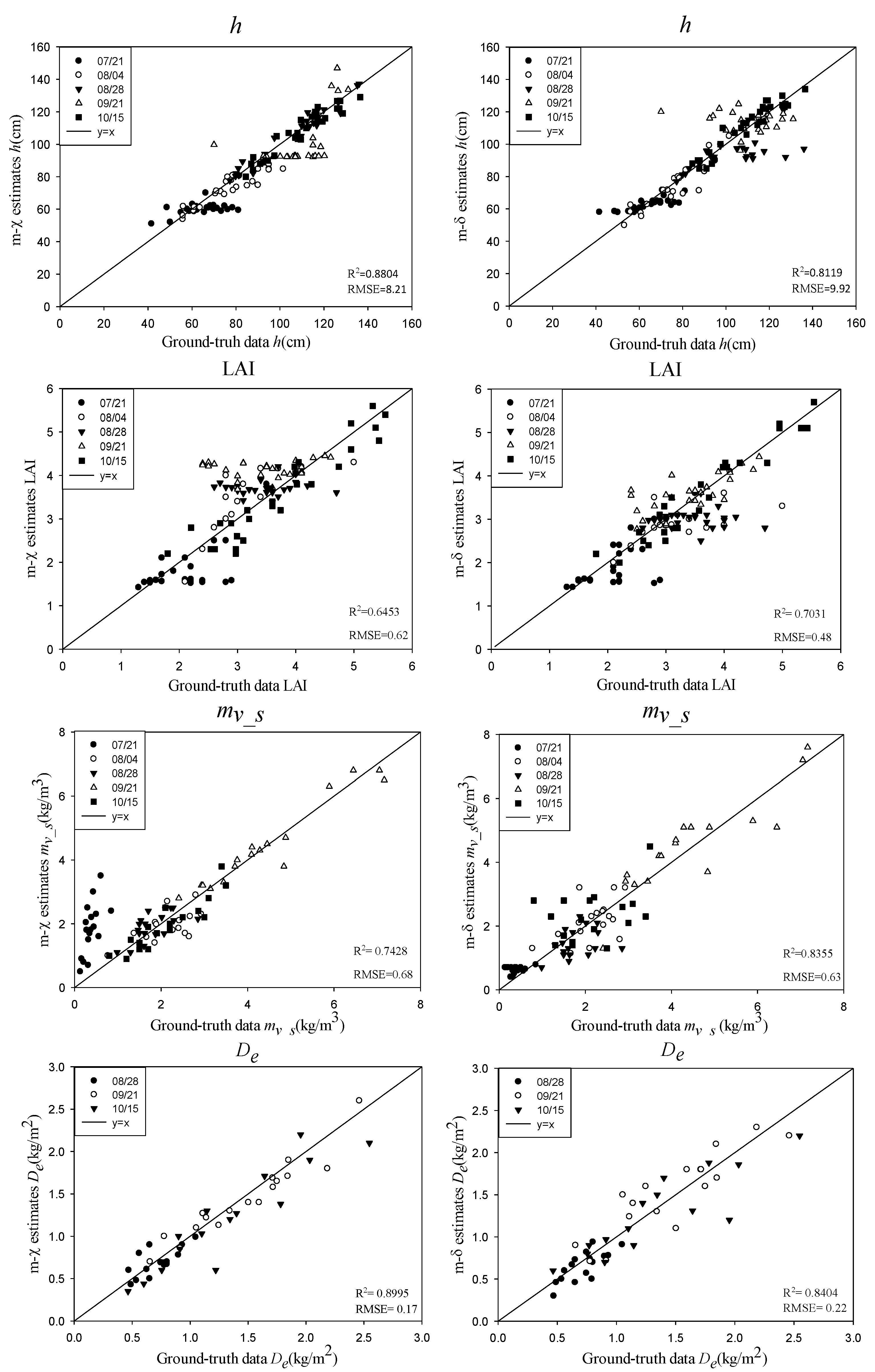
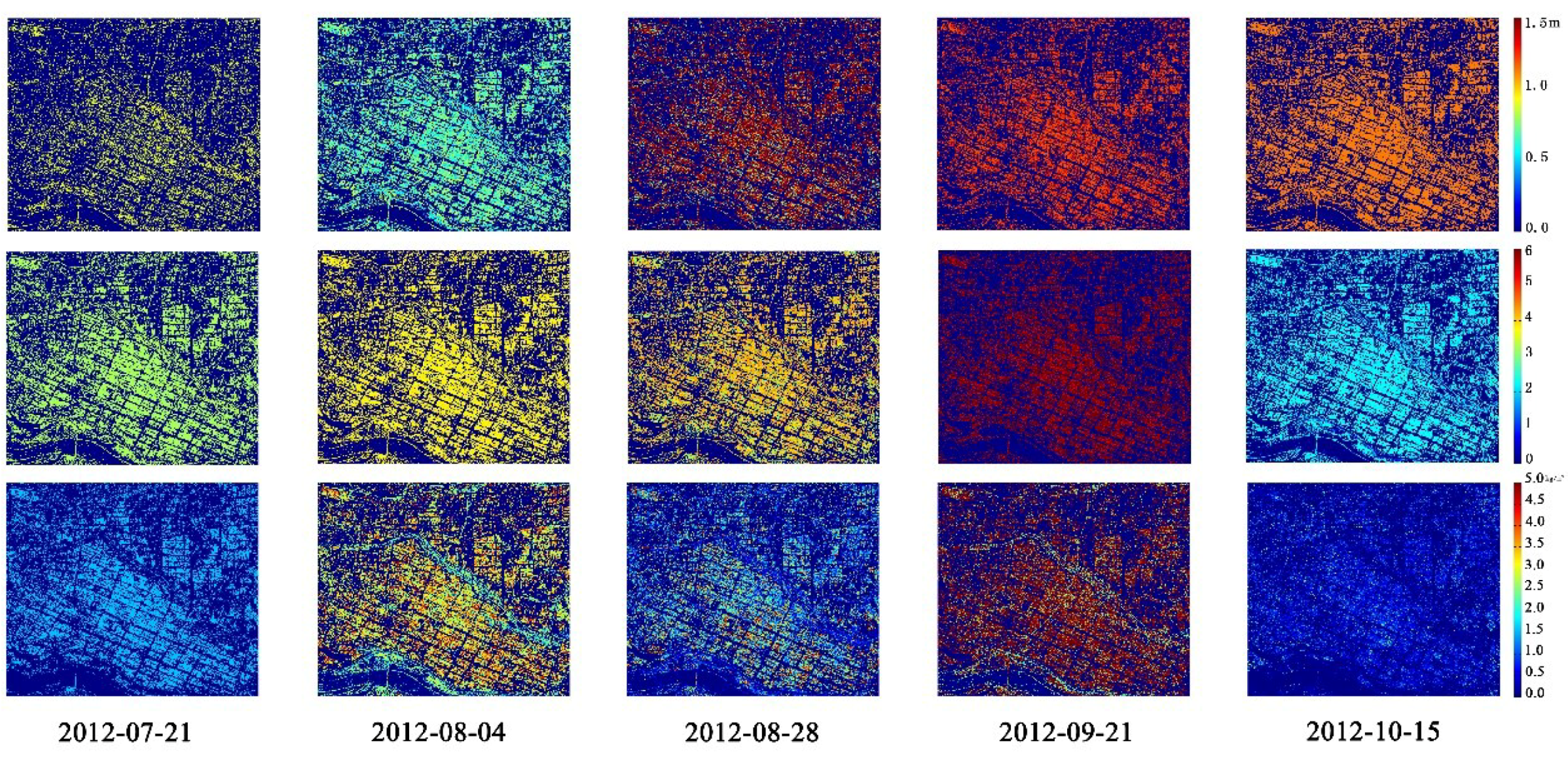

| Date | Mode | Product | Incidence Angle (°) | Pixel Spacing (A × R, m) | Phenology Stage |
|---|---|---|---|---|---|
| 21 July 2012 | FQ20W 1 | SLC 2 | 38–41 | 5.2 × 7.6 | Elongation |
| 4 August 2012 | FQ9W | SLC | 27–30 | 5.2 × 7.6 | Booting |
| 28 August 2012 | FQ9W | SLC | 27–30 | 5.2 × 7.6 | Heading |
| 21 September 2012 | FQ9W | SLC | 27–30 | 5.2 × 7.6 | Dough |
| 15 October 2012 | FQ9W | SLC | 27–30 | 5.2 × 7.6 | Mature |
| Phenological Stages | Underlying Surface | Rice Part Scattering | Space Part Scattering | ||||||||
|---|---|---|---|---|---|---|---|---|---|---|---|
| Seedling | Water surface | Sg_r | Vf_r | Sg_s | Dg_f | ||||||
| Tillering to Booting | Water surface | Sg_r | Vf_r | St | Dg_t | Sg_s | Dg_f | Vf_s | |||
| Heading to Flowering | Moist soil | Sg_r | Vf_r | St | Dg_t | Ve_r | Sg_s | Vf_s | Dg_e | ||
| Dough to Mature | Moist soil | Sg_r | Vf_r | St | Dg_t | Ve_r | Sg_s | Vf_s | Dg_e | Ve_s | |
© 2018 by the authors. Licensee MDPI, Basel, Switzerland. This article is an open access article distributed under the terms and conditions of the Creative Commons Attribution (CC BY) license (http://creativecommons.org/licenses/by/4.0/).
Share and Cite
Guo, X.; Li, K.; Shao, Y.; Wang, Z.; Li, H.; Yang, Z.; Liu, L.; Wang, S. Inversion of Rice Biophysical Parameters Using Simulated Compact Polarimetric SAR C-Band Data. Sensors 2018, 18, 2271. https://doi.org/10.3390/s18072271
Guo X, Li K, Shao Y, Wang Z, Li H, Yang Z, Liu L, Wang S. Inversion of Rice Biophysical Parameters Using Simulated Compact Polarimetric SAR C-Band Data. Sensors. 2018; 18(7):2271. https://doi.org/10.3390/s18072271
Chicago/Turabian StyleGuo, Xianyu, Kun Li, Yun Shao, Zhiyong Wang, Hongyu Li, Zhi Yang, Long Liu, and Shuli Wang. 2018. "Inversion of Rice Biophysical Parameters Using Simulated Compact Polarimetric SAR C-Band Data" Sensors 18, no. 7: 2271. https://doi.org/10.3390/s18072271






